
Clam is a common name for several kinds of bivalve molluscs. The word is often applied only to those that are edible and live as infauna, spending most of their lives halfway buried in the sand of the seafloor or riverbeds. Clams have two shells of equal size connected by two adductor muscles and have a powerful burrowing foot. They live in both freshwater and marine environments; in salt water they prefer to burrow down into the mud and the turbidity of the water required varies with species and location; the greatest diversity of these is in North America.
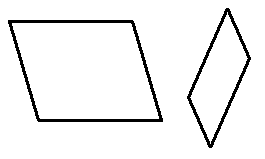
Traditionally, in two-dimensional geometry, a rhomboid is a parallelogram in which adjacent sides are of unequal lengths and angles are non-right angled.
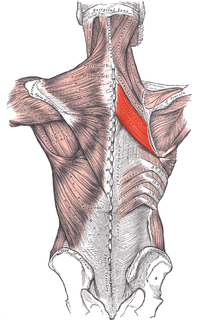
The rhomboid major is a skeletal muscle on the back that connects the scapula with the vertebrae of the spinal column. In human anatomy, it acts together with the rhomboid minor to keep the scapula pressed against thoracic wall and to retract the scapula toward the vertebral column.

In human anatomy, the rhomboid minor is a small skeletal muscle on the back that connects the scapula with the vertebrae of the spinal column.
Perkinsus is a genus of alveolates in the phylum Perkinsozoa. The genus was erected in 1978 to better treat its type species, Perkinsus marinus, known formerly as Dermocystidium marinum. These are parasitic protozoans that infect molluscs, at least some of which cause disease and mass mortality. P. marinus is the most notorious, causing the disease perkinsosis, or dermo, in wild and farmed oysters.
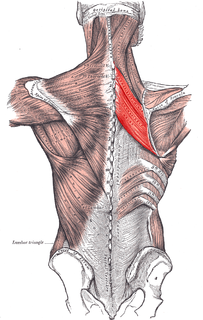
The rhomboid muscles, often simply called the rhomboids, are rhombus-shaped muscles associated with the scapula. There are two rhomboid muscles on each side of the upper back:
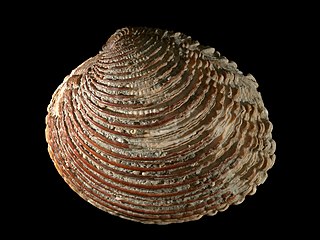
The Veneridae or venerids, common name: Venus clams, are a very large family of minute to large, saltwater clams, marine bivalve molluscs. Over 500 living species of venerid bivalves are known, most of which are edible, and many of which are exploited as food sources.
Ulmus × hollandica 'Folia Rhomboidea' is one of a number of cultivars possibly arising from the crossing of the Wych Elm Ulmus glabra with a variety of Field Elm Ulmus minor. First mentioned by Morren in 1851 as U. campestris latifolia, foliis rhomboides.
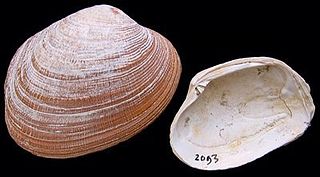
The grooved carpet shell, or Palourde clam, Ruditapes decussatus, or Venerupis decussatus, is a clam in the family Veneridae. It is distributed worldwide and due to its ecological and economic interest has been proposed as a bioindicator.

Goneplax rhomboides is a species of crab. It is known by the common name angular crab because of its angular carapace. Although it is also called the square crab, its shell is in fact more trapezoidal than square. This species is also known as the mud-runner because they are able to run away quickly when threatened.

Lagodon is a genus of saltwater fish in the family Sparidae, the breams and porgies. It is monotypic, being represented by the single species Lagodon rhomboides, commonly known as pinfish. Other common names include pin perch, sand perch, and butterfish. It inhabits mostly subtropical shallow coastal waters of the Atlantic and Gulf coasts of the United States and Mexico.
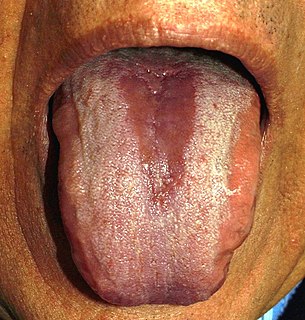
Median rhomboid glossitis is a condition characterized by an area of redness and loss of lingual papillae on the central dorsum of the tongue, sometimes including lesions of the tongue and palate. It is seen in patients using inhaled steroids and smokers, and is usually a kind of chronic atrophic oral candidiasis, but hematinic deficiency and diabetes should be excluded.

Venerupis is a genus of marine bivalve molluscs in the family Veneridae commonly known as carpet shells. The valves are robust and rhomboidal with the umbones turned-in and nearer the anterior end. The posterior end is wedge-shaped and the internal margins of the valves are smooth. There are 3 or 4 cardinal teeth on each valve. The foot is large and the siphons are of medium length and united except at the very tip.
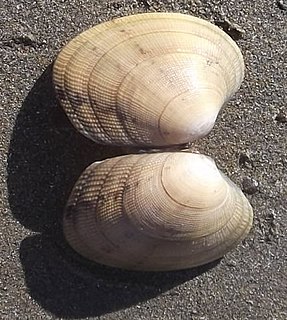
Venerupis decussata is a marine bivalve mollusc in the family Veneridae, commonly known as the cross-cut carpet shell.

Venerupis corrugata, the pullet carpet shell, is a species of bivalve mollusc in the family Veneridae. It is found buried in the sediment on the sea bed in shallow parts of the eastern Atlantic Ocean. It is harvested for human consumption in Spain and other parts of Western Europe.

The old woman angelfish is a species of marine ray-finned fish, a marine angelfish belonging to the family Pomacanthidae. It is found in the western Indian Ocean.
Arcobacter venerupis is a species of Gram-negative, slightly curved motile rod-shaped bacteria. It was first recovered from mussels and clams. Its type strain is F4(T)=CECT 7835(T)=LMG 26154(T)).
Polititapes is a genus of marine bivalve molluscs in the subfamily Tapetinae of the family Veneridae, commonly known as carpet shells.

Polititapes aureus is a species of bivalve belonging to the family Veneridae.
Nepenthes longiptera is a tropical pitcher plant endemic to the province of Aceh in the island of Sumatra in Indonesia. Nepenthes longiptera differs from all other Nepenthes species from Sumatra by the presence of wings on its upper pitchers. Morphologically, this species closely resembled N. tobaica, but differs on its much larger habit, the well-developed wings of its upper pitchers, the rhomboid-shaped cross-section of the stem, and the presence of appendage under the lid.















